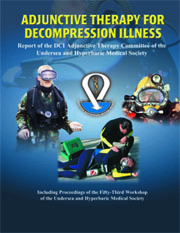Report of the Decompression Illness Adjunctive Therapy Committee of the Undersea and Hyperbaric Medical Society

Report of the Decompression Illness Adjunctive Therapy Committee of the Undersea and Hyperbaric Medical Society Summary:
CLICK HERE for the Full report
American Heart Association Guidelines for Clinical Efficacy:
- Class 1: Conditions for which there is evidence and/or general agreement that a given procedure or treatment is useful and effective
- Class 2: Conditions for which there is conflicting evidence and/or a divergence of opinion about the usefulness/efficacy of a procedure or treatment
- Class 2A: Weight of evidence/opinion is in favor of usefulness/efficacy
- Class 2B: Usefulness/efficacy is less well established by evidence/opinion
- Class 3: Conditions for which there is evidence and/or general agreement that the procedure/treatment is not useful/effective and in some cases may be harmful
- Level of Evidence A: Data derived from multiple randomized clinical trials
- Level of Evidence B: Data derived from a single randomized trial or nonrandomized studies
- Level of Evidence C: Consensus opinion of experts
UHMS Guidelines for Adjunctive Therapy of DCI
| Aspirin | ||
| Class | Level | |
| AGE (no significant inert gas load) | 2B | C |
| DCS: pain only/mild | 2B | C |
| DCS: neurological | 2B | C |
| DCS: chokes | 2B | C |
| NSAIDs* | ||
| Class | Level | |
| AGE (no significant inert gas load) | 2B | C |
| DCS: pain only/mild | 2B | B |
| DCS: neurological | 2B | B |
| DCS: chokes | 2B | C |
* The only evidence thus far available applies to the use of tenoxicam, a nonselective inhibitor of cyclooxygenase (COX). NSAIDs are not currently recommended for use in the field. Use of nonselective COX inhibitors, because of their effect on platelet function, could engender some risk for combat divers who may be required to return to action after treatment of an episode of decompression illness.
Disclosure: The views, opinions, and findings contained herein are those of the author(s) and should not be construed as an official Agency position, policy, or decision unless so designated by other official documentation.
